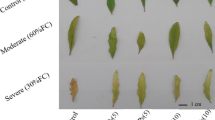Abstract
The allelopathic effect of parthenium (Parthenium hysterophorus L.) leaf residue (dry leaf powder, DLP) on water hyacinth (Eichhornia crassipes Mart Solms.) was studied. The treatment caused wilting starting from the margins of the older leaves and desiccation of above-water plant parts (shoot). Appearance, persistence, and disappearance of symptoms depended on the level and duration of the treatment and recovery of the treated plants, if it occurred. The treatment drastically reduced the number of healthy leaves (HLN) and the plant biomass at 0.25% (w/v) DLP; the treated plants recovered in about one month. At and above 0.50% (w/v) DLP, the plants were killed in about one month, resulting in sinking of the dead mass in water. Physiological effects of the treatment included deterioration of membrane integrity, loss of dehydrogenase activity with concurrent drastic reduction or total failure of water absorption by the roots, and reduction of chlorophyll contents in the leaves. The results indicate that the inhibitors leached out of the DLP affected the water hyacinth plants through changes in macromolecules: protein, lipid, and nucleic acid, resulting in root dysfunction and other inhibitory activities both in the root and shoot. Phenolic and other inhibitors including those found in the parthenium plant (except sesquiterpene lactones which have not been tested) at 50 ppm, exceptp-hydroxybenzoic acid, did not affect the treated plants. Such a high concentration of the allelochemicals is unlikely to be present in the medium at the lethal dose (0.50% w/v) of the DLP. Even withp-hydroxybenzoic acid, the plants recovered subsequently and grew normally. Thus, it appears that other allelochemicals including sesquiterpene lactones were mainly responsible for the inhibitory activity of the DLP on water hyacinth plants.
Similar content being viewed by others
References
Arnon, D.I. 1949. Copper enzymes in isolated chloroplast. Polyphenol oxidase inBeta vulgaris.Plant Physiol. 24:1–15.
Kanchan, S.D. 1975. Growth inhibitors fromParthenium hysterophorus L.Curr. Sci. (India) 44:358–359.
Kanchan, S.D., andJayachandra. 1979a. Allelopathic effects ofParthenium hysterophorus L. I. Exudation of inhibitors through roots.Plant Soil 53:27–35.
Kanchan, S.D., andJayachandra. 1979b. Allelopathic effects ofParthenium hysterophorus L. III. Inhibitory effects of the weed residue.Plant Soil 53:37–47.
Kanchan, S.D., andJayachandra. 1980. Allelopathic effects ofParthenium hysterophorus L. IV. Identification of inhibitors.Plant Soil 55:67–75.
Mackay, D.B. 1972. The measurement of viability, pp. 172–208,in E.H. Roberts (ed.). Viability of Seeds. Chapman and Hall Ltd., London.
Mersie, W., andSingh, M. 1987. Allelopathic effect of parthenium (Parthenium hysterophorus L.) extract and residue on some agronomic crops and weeds.J. Chem. Ecol. 13:1739–1747.
Mersie, W., andSingh, M. 1988. Effect of phenolic acids and ragweed parthenium (Parthenium hysterophorus L.) extracts on tomato (Lycopersicon esculentum) growth and nutrient and chlorophyll content.Weed Sci. 36:278–281.
Pandey, D.K. 1989. Aging of Frenchbean seeds at ambient temperature in relation to vigour and viability.Seed Sci. Technol. 17:41–47.
Picman, A.K. 1986. Biological activities of sesquiterpene lactones.Biochem. Syst. Ecol. 14:255–281.
Picman, J., andPicman, A.K. 1984. Autotoxicity inParthenium hysterophorus and its possible role in control of germination.Biochem. Syst. Ecol. 12:287–292.
Salisbury, F.B., andRoss, C.W. 1984. Osmosis. Plant Physiology, Wadsworth Publishing, Belmont, pp. 33–53.
Sharma, K.K.V., Giri, O.S., andSubramanyam, K. 1976. Allelopathic potential ofParthenium hysterophorus L. on seed germination and dry matter production inArachis hypogea Willd.,Crotalaria juncea L. andPhaseolus mungo L.Trop. Ecol. 17:76–77.
Swain, T., andHillis, W.E. 1959. The phenolic constituents ofPrunus domestica. I. The quantitative analysis of phenolic constituents.J. Sci. Food Agric. 10:63–68.
Towers, G.H.N., Mitchell, J.C., Rodriguez, E., Bennett, F.D., andSubbarao, P.V. 1977. Biology and chemistry ofParthenium hysterophorus L., a problem weed in India.J. Sci. Ind. Res. 36:672–684.
Author information
Authors and Affiliations
Rights and permissions
About this article
Cite this article
Pandey, D.K., Kauraw, L.P. & Bhan, V.M. Inhibitory effect of parthenium (Parthenium hysterophorus L.) residue on growth of water hyacinth (Eichhornia crassipes mart solms.) I. Effect of leaf residue. J Chem Ecol 19, 2651–2662 (1993). https://doi.org/10.1007/BF00980698
Received:
Accepted:
Issue Date:
DOI: https://doi.org/10.1007/BF00980698




